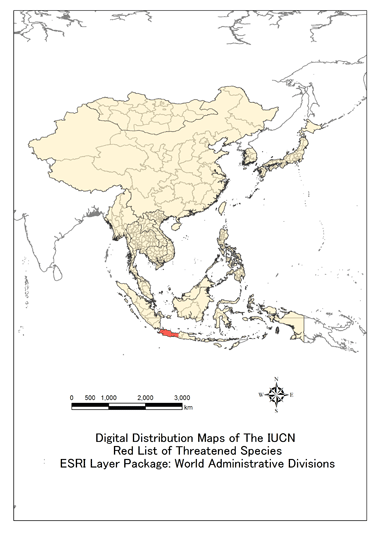
TOP > 生物多様性センターの国際協力 > ESABII > Database > Threatened Mammal Species Database > Nycticebus javanicus

Nycticebus javanicus
Taxonomy (Name)
| Class | MAMMALIAIUCN | |
|---|---|---|
| Order | DIPROTODONTIAIUCN | |
| Family | LORISIDAEIUCN | |
| Scientific Name | Nycticebus javanicusIUCN | |
| Author | E. Geoffroy, 1812IUCN | |
| Synonyms | ||
| Common Name | Javan Slow LorisIUCN | |
| Local name | Brunei Darussalam | |
| Cambodia | ||
| China | ||
| Indonesia | ||
| Japan | ||
| Lao PDR | ||
| Malaysia | ||
| Myanmar | ||
| Mongolia | ||
| Philippines | ||
| Singapore | ||
| Republic of Korea | ||
| Thailand | ||
| Vietnam | ||
Picture
Distribution, Range
This species is only known from western and central Java in Indonesia.
Map


Country
| Brunei Darussalam | |
|---|---|
| Cambodia | |
| China | |
| Indonesia | |
| Japan | |
| Lao PDR | |
| Malaysia | |
| Myanmar | |
| Mongolia | |
| Philippines | |
| Singapore | |
| Republic of Korea | |
| Thailand | |
| Vietnam |
Status
International Status
IUCN Red List Category
ENIUCN
Justification
This species is listed as Endangered due to a suspected decline of at least 50% over the last three generations (approximately 21-24 years) due to severe and persistent persecution for the pet trade. Much of the habitat has also disappeared for the species, though much of this was lost more than three generations ago.
CITES
Appendix IIUCN
CMS
National Status
| Country | Category | Reference |
|---|---|---|
| Brunei Darussalam | ||
| Cambodia | ||
| China | ||
| Indonesia | ||
| Japan | ||
| Korea | ||
| Lao PDR | ||
| Malaysia | ||
| Mongolia | ||
| Myanmar | ||
| Philippines | ||
| Singapore | ||
| Thailand | ||
| Vietnam |
Ecology Discription
Appearance
Habitat
This species is nocturnal and arboreal, and is found in both primary and secondary disturbed forest. Thought to occur between 0 and 1,600 m, although it seems to be more common at higher elevations (likely due to the fact that lower elevation habitat is rare) (A. Nekaris pers. comm.). Further studies are urgently needed.
Population size
This species has been recorded at very low densities (0.20-0.02/km) (Nekaris et al. in review).
Behavior
It needs arboreal connectivity (vines and lianas) due to its unique locomotive adaptations.
Diet
It feeds on sap and floral florescence and on gum and insects.
Reproduction
Threat
Major Threat(s)
This species is used for traditional ?medicines? (Nekaris and Nijman 2007). Due to their non-saltatory locomotion, their choice of sleeping sites on exposed branches, and nocturnal habits, the animals are easily caught by humans, who seek them both for the pet trade as well as opportunistically collect them during forest felling (Nekaris and Bearder 2007). It is also threatened locally by the loss of forest habitat.
Conservation and Measurement
International
This species is protected by Indonesian law and is listed on CITES Appendix I.
National
It occurs in several protected areas, though its status there is uncertain (Nekaris et al. 2008), and is currently represented in at least three captive collections (Prague, Czech Republic; Jakarta, Indonesia; Singapore). There is a need for field guides for this and other Southeast Asian nocturnal primate species as they are often confused in rescue centers and elsewhere.
Conservation law
| Country | Status | Reference |
|---|---|---|
| Brunei Darussalam | ||
| Cambodia | ||
| China | ||
| Indonesia | ||
| Japan | ||
| Korea | ||
| Lao PDR | ||
| Malaysia | ||
| Mongolia | ||
| Myanmar | ||
| Philippines | ||
| Singapore | ||
| Thailand | ||
| Vietnam |
Protected Area
Other Coservation Projects
Citation
Groves, C. P. 2001. Primate taxonomy. Smithsonian Institution Press, Washington, DC, USA.
IUCN. 2008. 2008 IUCN Red List of Threatened Species. Available at: http://www.iucnredlist.org. (Accessed: 5 October 2008).
Nekaris, K. A. I. and Bearder, S. 2007. The strepsirrhine primates of Asia and Mainland Africa: diversity shrouded in darkness. In: S. K. Bearder, C. Campbell, A. Fuentes, K. MacKinnon and M. Panger (eds), Primates in Perspective, pp. 24-45. Oxford University Press, Oxford, UK.
Nekaris, K. A. I. and Jaffe, S. 2007. Unexpected diversity within the Javan slow loris trade: implications for slow loris taxonomy. Contributions to Zoology 76: 187-196.
Nekaris, K. A. I. and Nijman, V. 2007. CITES proposal highlights rarity of asian nocturnal primates (Lorisidae: Nycticebus). Folia Primatologica 78: 211-214.
Nekaris, K. A. I., Blackham, G. V. and Nijman, V. 2008. Conservation implications of low encounter rates of five nocturnal primate species (Nycticebus spp.) in Asia. Biodversity and Conservation 17(4): 733-747.
Nekaris, K., Roos, C., Pimley, E. and Schulze, H. 2006. Diversity slowly coming to light: reconsidering the taxonomy of pottos and lorises. International Journal of Primatology 27(1): 441.
Thomas, O. 1921. Two new species of slow-loris. Annals and Magazine of Natural History 8: 627?628.
